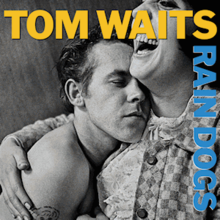Rain Dogs is the eighth album by American singer-songwriter Tom Waits, released in September 1985 on Island Records.
A loose concept album about "the urban dispossessed" of New York City, Rain Dogs is generally considered the middle album of a trilogy that includes Swordfishtrombones and Franks Wild Years.
The album, which includes appearances by guitarists Keith Richards and Marc Ribot, is noted for its broad spectrum of musical styles and genres, described by Rolling Stone as merging "Kurt Weill, pre-rock integrity from old dirty blues, [and] the elegiac melancholy of New Orleans funeral brass, into a singularly idiosyncratic American style."
The album peaked at #29 on the UK charts and #188 on the US Billboard Top 200. In 1989, it was ranked #21 on the Rolling Stone list of the "100 greatest albums of the 1980s." In 2003, the album was ranked number 397 on the magazine's list of "The 500 Greatest Albums of All Time".
Waits wrote the majority of the album in a two month stint in the fall of 1984 in a basement room at the corner of Washington and Horatio Streets in Manhattan. According to Waits, it was:
kind of a rough area, Lower Manhattan between Canal and 14th street, just about a block from the river ... It was a good place for me to work. Very quiet, except for the water coming through the pipes every now and then. Sort of like being in a vault.In preparation for the album, Waits recorded street sounds and other ambient noises on a cassette recorder in order to get the sound of the city that would be the album's subject matter.
A wide range of instruments were employed to achieve the album's sound, including marimba, accordion, double bass, trombone, and banjo, indicating the many different musical directions spread across Rain Dogs. Coming as it did in the mid 1980s—when most musicians depended on synthesizers, drum machines, and studio techniques to create their music—the album is notable for its organic sound, and the means by which it was achieved. Waits, discussing his mistrust of then fashionable studio techniques, said:
If I want a sound, I usually feel better if I've chased it and killed it, skinned it and cooked it. Most things you can get with a button nowadays. So if I was trying for a certain drum sound, my engineer would say: "Oh, for Christ's sake, why are we wasting our time? Let's just hit this little cup with a stick here, sample something (take a drum sound from another record) and make it bigger in the mix, don't worry about it." I'd say, "No, I would rather go in the bathroom and hit the door with a piece of two-by-four very hard."Waits also stated that "if we couldn't get the right sound out of the drum set we'd get a chest of drawers in the bathroom and bang it real hard with a two-by-four," such that "the sounds become your own."
Rain Dogs marked the first time that Waits worked with guitarist Marc Ribot, who was impressed by Waits' unusual studio presence:
Rain Dogs was my first major label type recording, and I thought everybody made records the way Tom makes records. ... I've learned since that it's a very original and individual way of producing. As producer apart from himself as writer and singer and guitar player he brings in his ideas, but he's very open to sounds that suddenly and accidentally occur in the studio. I remember one verbal instruction being, "Play it like a midget's bar mitzvah."Ribot also recalls how the band would not rehearse the songs before going to record; rather, Waits would play them the songs on an acoustic guitar in the studio.
He had this ratty old hollow body, and he would spell out the grooves. It wasn't a mechanical kind of recording at all. He has a very individual guitar style he sort of slaps the strings with his thumb ... He let me do what I heard, there was a lot of freedom. If it wasn't going in a direction he liked, he'd make suggestions. But there's damn few ideas I've had which haven't happened on the first or second take.The album marks the first time Waits recorded with guitarist Keith Richards of The Rolling Stones. As to the reasons for getting Richards involved, and concerning their working relationship in the studio, Waits said:
There was something in there that I thought he would understand. I picked out a couple of songs that I thought he would understand and he did. He's got a great voice and he's just a great spirit in the studio. He's very spontaneous, he moves like some kind of animal. I was trying to explain "Big Black Mariah" and finally I started to move in a certain way and he said, "Oh, why didn't you do that to begin with? Now I know what you're talking about." It's like animal instinct.According to Barney Hoskyns, the album's general theme of "the urban dispossessed" was inspired in part by Martin Bell's 1984 documentary Streetwise, to which Waits had been asked to contribute music.
Though it has been remarked that the man on the cover bears a striking resemblance to Waits, the photograph is actually one of a series taken by the Swedish photographer Anders Petersen at Café Lehmitz (a café near the Hamburg red-light boulevard Reeperbahn) in the late 1960s. The man and woman depicted on the cover are called Rose and Lily.
The cover-text resembles - in placement and font - Elvis Presley's self-titled debut album, as well as The Clash's London Calling. The European version of the cover features red rather than blue text, as in the former albums.
Read full article @ Wikipedia

No comments:
Post a Comment